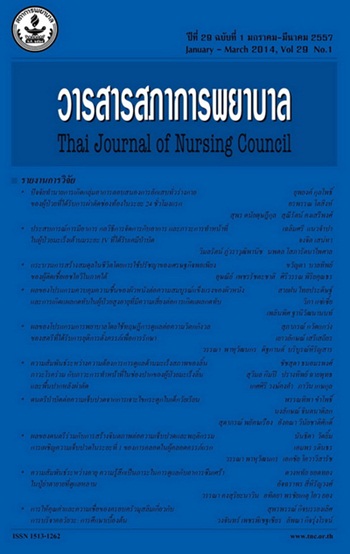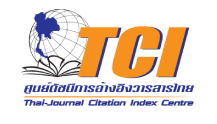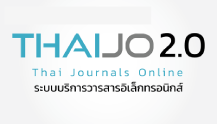ความสัมพันธ์ระหว่างความต้องการการดูแลด้านมะเร็ง สภาพของลิ้น ภาวะโรคร่วม กับภาวะการทำหน้าที่ในช่องปากของผู้ป่วยมะเร็งลิ้นและพื้นปากหลังผ่าตัด
Keywords:
มะเร็งลิ้น มะเร็งพื้นปาก ความต้องการการดูแลด้านมะเร็ง สภาพของลิ้น ภาวะโรคร่วม ภาวะการทำหน้าที่ในช่องปาก cancer of tongue, cancer of floor of mouth, cancer caring needs, condition of the tongue, comorbidity, oral functional statusAbstract
บทคัดย่อ : วัตถุประสงค์ของการวิจัย : ศึกษาความสัมพันธ์ระหว่างความต้องการการดูแลด้านมะเร็ง สภาพของลิ้น ภาวะโรคร่วม กับภาวะการทำหน้าที่ในช่องปากของผู้ป่วยมะเร็งลิ้นและพื้นปากหลังผ่าตัด
การออกแบบวิจัย: การวิจัยเชิงความสัมพันธ์
การดำเนินการวิจัย: การวิจัยนี้ใช้ทฤษฎีการปรับตัวของรอย เป็นกรอบแนวคิดในการวิจัย กลุ่มตัวอย่างเป็นผู้ป่วยมะเร็งลิ้นและพื้นปากหลังผ่าตัดภายใน 6 สัปดาห์ ก่อนได้รับรังสีรักษา และ/หรือเคมีบำบัด ณ โรงพยาบาลระดับตติยภูมิ 4 แห่ง ในกรุงเทพมหานคร จำนวน 57 ราย เก็บรวบรวมข้อมูลโดยใช้แบบสอบถามข้อมูลทั่วไป แบบสอบถามความต้องการการดูแลด้านมะเร็งอย่างสั้นสำหรับผู้ป่วยมะเร็งศีรษะและคอ แบบประเมินสภาพลิ้นสำหรับผู้ป่วยมะเร็งลิ้นและพื้นปาก แบบประเมินภาวะโรคร่วมของชาร์ลสัน แบบประเมินภาวะการทำหน้าที่ในช่องปาก ในด้านการกลืนและการพูด วิเคราะห์ข้อมูลโดยใช้สถิติสหสัมพันธ์สเปียร์แมน
ผลการวิจัย: พบว่าสภาพของลิ้นมีความสัมพันธ์เชิงบวกกับภาวะการทำหน้าที่ในช่องปากอย่างมีนัยสำคัญทางสถิติ (r = .623, p < .01) ความต้องการการดูแลด้านมะเร็งมีความสัมพันธ์เชิงลบกับภาวะการทำหน้าที่ในช่องปากอย่างมีนัยสำคัญทางสถิติ (r = -.308, p < .05) และภาวะโรคร่วมไม่มีความสัมพันธ์กับภาวะการทำหน้าที่ในช่องปาก (r = .075, p > .05)
ข้อเสนอแนะ: พยาบาลควรตอบสนองความต้องการการดูแลด้านมะเร็งของผู้ป่วย รวมถึงเน้นการดูแลสภาพของลิ้นภายหลังผ่าตัด เพื่อส่งเสริมให้สภาพลิ้นมีการฟื้นตัวเร็ว ส่งผลให้มีภาวะการทำหน้าที่ในช่องปากดี
Abstract: Objective: To examine correlation between cancer care needs, tongue condition, comorbidity and oral functional status in patients having undergone tongue cancer and mouth-floor cancer operations. Design: Correlational research. Implementation: This study was conducted based on Roy’s Adaptation Model as a conceptual framework. The sample consisted of 57 post-operative tongue cancer and mouth-floor cancer patients scheduled to receive radiotherapy and/or chemotherapy within 6 weeks. Data were collected using (i) a general information questionnaire, (ii) a short form surveying cancer care needs in patients with head and neck cancers, (iii) a tongue condition assessment form, (iv) Charlson’s comorbidity index, and (v) an oral functional (swallowing and speaking) status form. The data were analysed using Spearman’s Rho correlation. Results: Firstly, tongue condition and oral functional status displayed a positive correlation, at a statistically significant level of r = .623, p < .01. Secondly, cancer care needs and oral functional status showed a negative correlation, at a statistically significant level of r = -.308, p < .05. Finally, comorbidity displayed no significant correlation (r = .075, p > .05) with oral functional status. Recommendations: It is suggested that nurses respond promptly to cancer patients’ care needs and pay close attention to the patients’ post-operative tongue conditions, as these could effectively enhance the recovery of the tongue and oral functional status.






